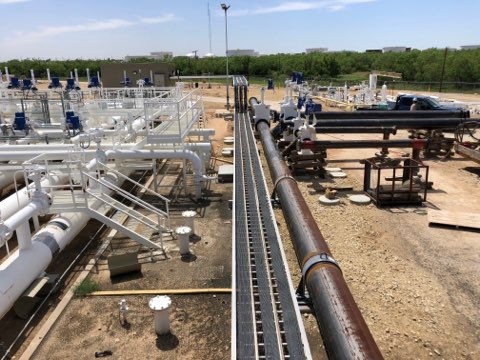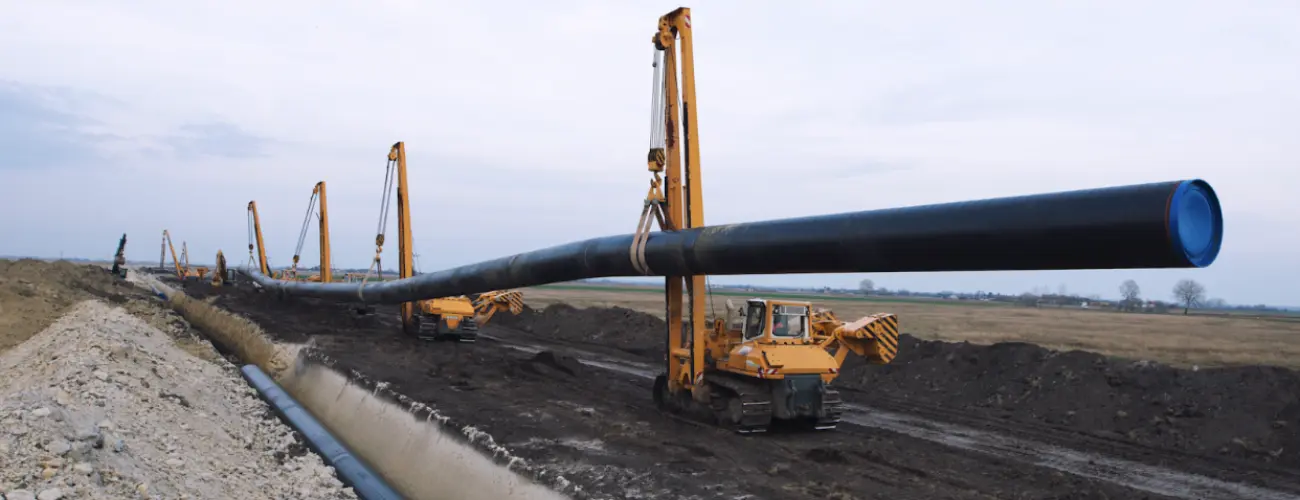Why Quality Pipeline Construction Services Are Essential for Long-Term Efficiency
Wiki Article
Exploring the most up to date Technologies in Pipeline Construction Services for Modern Projects
The Pipeline Construction market is undergoing substantial adjustments. Innovations such as smart materials and robotics are improving standard methods. These advancements promise to improve efficiency and safety and security. Furthermore, AI modern technologies are boosting job administration abilities. As these components merge, they question about their long-lasting effect on sustainability and cost. Recognizing these innovations is essential for stakeholders wanting to browse this advancing landscape. What ramifications do they hold for future tasks?The Rise of Smart Materials in Pipeline Construction
As the demand for a lot more sustainable and effective Pipeline systems boosts, the combination of wise materials has arised as a transformative option in Pipeline Construction. These advanced materials possess one-of-a-kind homes that improve the efficiency and long life of pipelines. As an example, self-healing polymers can immediately repair minor leakages, greatly reducing maintenance expenses and downtime. Furthermore, materials embedded with sensors can keep an eye on structural integrity and environmental problems, enabling real-time information collection and evaluation.Additionally, wise materials are usually lightweight and corrosion-resistant, which not just simplifies installment however also extends the life-span of the systems. Their adaptability makes it possible for pipelines to stand up to extreme environmental problems, advertising safety and security and dependability. As sectors progressively prioritize sustainability, using environment-friendly smart products adds to decreased ecological influence. On the whole, the surge of smart products notes a notable change in Pipeline Construction, paving the means for innovative solutions to satisfy contemporary infrastructure needs.
Innovations in Robotics for Installation and Maintenance
The integration of smart materials in Pipeline Construction is enhanced by innovations in robotics, which are changing setup and upkeep processes. Robot technologies, such as automated welding systems and drones, enhance efficiency and precision, lowering human mistake and minimizing security dangers. These robotics can run in tough settings, making certain that installations are conducted in harmful or remote areas without placing employees in danger.Robot examination devices furnished with innovative sensing units supply real-time data on Pipeline stability, allowing for proactive upkeep. They can find leakages or structural weaknesses, enabling prompt treatments that extend the lifespan of Pipeline systems. The usage of robotics not just increases the Construction timeline however likewise maximizes resource appropriation, resulting in cost financial savings. As these modern technologies continue to evolve, they are readied to play a vital role in shaping the future of Pipeline Construction, making certain reliability and sustainability in facilities growth.
AI-Driven Project Monitoring Equipment Changing Workflow
AI-driven project administration tools are reshaping operations in Pipeline Construction by enhancing decision-making processes with enhanced accessibility to real-time data analytics. These tools make it possible for teams to react swiftly to project advancements, consequently boosting efficiency. Structured communication networks foster partnership amongst stakeholders, even more optimizing project results.Boosted Decision-Making Processes

Real-Time Information Analytics
Taking advantage of real-time data analytics, modern-day project monitoring tools transform workflow in Pipeline Construction. These advanced tools utilize artificial knowledge to supply immediate understandings right into project performance, resource appropriation, and possible risks. By continuously keeping an eye on crucial performance indications, groups can promptly adapt to changing conditions, optimizing labor and materials usage. The assimilation of real-time information enables even more enlightened decision-making, lowering hold-ups and decreasing costs. On top of that, predictive analytics can recognize patterns and forecast obstacles prior to they rise, improving overall job efficiency. Consequently, Pipeline Construction business that embrace these AI-driven tools can enhance job timelines and results, guaranteeing they continue to be affordable in a significantly intricate sector landscape. This technology notes a considerable shift toward data-centric management techniques.Streamlined Communication Networks
Reliable interaction is paramount in Pipeline Construction, where countless stakeholders must work together flawlessly to assure project success. The introduction of AI-driven job management tools has transformed interaction channels within the industry. These devices promote real-time details sharing, allowing groups to accessibility updates, share documents, and track development effectively. By automating regular tasks and supplying a central system for communication, these advancements remove misunderstandings and reduce delays. Enhanced visibility right into task timelines and source allocation cultivates responsibility among staff member. Additionally, AI analytics can identify possible interaction voids, making certain proactive analytical. Inevitably, streamlined interaction networks not just improve operations however also raise overall task efficiency, enabling Pipeline Construction companies to fulfill modern demands efficiently.Boosted Security Protocols Via Modern Technology Assimilation
The assimilation of innovation in Pipeline Construction has actually resulted in improved safety protocols. Real-time surveillance systems, wearable safety and security devices, and automated risk evaluations are currently important components in decreasing hazards on work websites. These technologies not just enhance employee security yet also simplify compliance with industry guidelines.Real-Time Surveillance Equipments
Just how can real-time surveillance systems transform Pipeline Construction safety and security methods? By integrating sophisticated modern technology, these systems supply continual monitoring of Construction activities, guaranteeing prompt discovery of possible hazards. Sensors and video cameras can check ecological problems, devices performance, and workforce activities, supplying vital data in actual time. This positive method enables task managers to determine dangers prior to they escalate, substantially boosting precaution on-site. In addition, real-time tracking helps with compliance with regulatory requirements, making sure that safety standards are met regularly. The capability to assess data instantaneously sustains enlightened decision-making, allowing prompt treatments. As an outcome, Pipeline Construction jobs can operate a lot more successfully while safeguarding the wellness of workers and lessening crashes, thereby transforming the industry's security landscape.Wearable Security Gadgets
Frequently, wearable safety tools are being integrated right into Pipeline Construction to boost safety and security procedures. These cutting-edge tools, including smart headgears, vests, and wristbands, are developed to keep an eye on worker health and wellness and ecological problems in real-time. Geared up with sensing units, these devices can detect dangers such as toxic gas exposure, too much warm, or high noise levels, offering immediate informs to managers and workers. Additionally, wearable innovation frequently includes GPS tracking functions, enabling effective place surveillance of personnel on-site. This ability not just help in quick feedback throughout emergencies yet also visit here boosts general job monitoring. By focusing on employee safety and security with technology assimilation, Pipeline Construction companies are making considerable strides in lowering accidents and advertising a society of safety within the sector.
Automated Danger Analyses
While traditional danger evaluations frequently count on hands-on assessments, the integration of automated danger evaluation innovations is changing safety procedures in Pipeline Construction. These advanced systems leverage data analytics, expert system, and artificial intelligence to determine possible risks a lot more precisely and efficiently. By constantly monitoring ecological conditions, equipment condition, and employee actions, automated analyses supply real-time insights that boost decision-making. This aggressive strategy reduces the probability of crashes and enhances conformity with safety policies. Furthermore, automated danger analyses can be upgraded quickly, ensuring that all stakeholders have accessibility to the most recent details. As an outcome, Pipeline Construction jobs take advantage of a more secure work atmosphere, reducing disturbances and promoting a society of safety via modern technology integration.Sustainable Practices in Pipeline Construction
As the need for power framework rises, the Pipeline Construction sector progressively focuses on sustainable methods that lessen environmental impact. Business are embracing green materials and sophisticated Construction methods to reduce their carbon footprint. For example, the usage of trenchless technology allows for Pipeline installment with very little disturbance to the surrounding setting, minimizing and maintaining all-natural environments dirt disintegration.
Furthermore, the implementation of renewable resource sources, such as solar or wind, to power Construction activities is obtaining traction. This shift not only lowers reliance on fossil fuels however also improves the overall sustainability of Pipeline tasks. Furthermore, reliable waste management methods, consisting of recycling and reusing products, are ending up being standard in the sector.
Real-Time Surveillance and Anticipating Upkeep Solutions
The change in the direction of lasting methods in Pipeline Construction has led the means for the assimilation of real-time tracking and predictive upkeep options. These innovations leverage progressed data and sensors analytics to continually examine Pipeline integrity and operational effectiveness. By gathering data in real time, drivers can detect abnormalities such as leakages or stress decreases before they escalate right into significant problems. This positive strategy not only decreases environmental dangers but additionally reduces downtime and maintenance costs.Anticipating upkeep employs algorithms to anticipate prospective failures based on historic information and current performance metrics. This enables prompt interventions, optimizing maintenance schedules and resource appropriation. Generally, real-time tracking and predictive upkeep services stand for a considerable development in Pipeline Construction, enhancing security and reliability while sustaining sustainability goals. As sectors remain to embrace these technologies, the operational landscape of Pipeline management is readied to evolve dramatically, making certain long-lasting stability and effectiveness.
The Function of Drones in Checking and Inspection
Drones have become transformative devices in the evaluating and evaluation of pipes, using boosted efficiency and accuracy. Their ability to record high-resolution photos and video clips from different angles permits detailed assessments of Pipeline integrity without taking the chance of human security. Equipped with advanced sensing units and thermal imaging abilities, drones can detect leakages, rust, and architectural abnormalities that might not be noticeable to the naked eye.The deployment of drones substantially reduces examination time, enabling quicker decision-making for maintenance and repair services. This effectiveness equates to cost financial savings and marginal disruption to surrounding atmospheres. Drones can likewise access hard-to-reach locations, such as raised structures or rugged surfaces, even more expanding the scope of inspections.
As the Pipeline market remains to welcome technological innovations, the assimilation of drones into surveying and evaluation processes is anticipated to expand, setting brand-new criteria for operational quality and security in Pipeline Construction services.
Frequently Asked Inquiries
What Are the Expenses Connected With Modern Pipeline Construction Innovations?
The prices related to contemporary Pipeline Construction innovations often include sophisticated products, specialized labor, and advanced innovation. These factors contribute to greater first investment, however can result in long-term savings with enhanced performance and reduced upkeep demands.Exactly How Do Governing Changes Effect Pipeline Construction Technologies?
Regulatory changes considerably affect Pipeline Construction technologies by requiring the adoption of safer, much more efficient methods. Conformity demands often drive technology, causing innovations in materials, style, and Construction methods that boost overall task sustainability and safety and security.What Skills Are Needed for Careers in Advanced Pipeline Construction?

Jobs in sophisticated Pipeline Construction need know-how in design principles, project management, safety and security procedures, and environmental regulations. Furthermore, skills in modern technology integration, synergy, and problem-solving are important for traversing the complexities of contemporary facilities tasks.
Just How Can Business Make Sure Compliance With Environmental Specifications?
To guarantee compliance with environmental standards, firms hop over to here ought to execute extensive training why not find out more programs, perform normal audits, and take on ideal practices in sustainability. Involving with stakeholders and monitoring governing changes better reinforces their dedication to ecological stewardship.
What Are the Secret Difficulties Dealing With Pipeline Construction Today?
The vital difficulties dealing with Pipeline Construction today consist of regulatory conformity, ecological issues, changing product expenses, labor lacks, and the requirement for advanced innovation assimilation (Pipeline Construction Services). These aspects complicate task timelines and total performance in the industryAs the demand for extra sustainable and efficient Pipeline systems boosts, the combination of wise products has actually arised as a transformative option in Pipeline Construction. AI-driven project monitoring tools are improving workflows in Pipeline Construction by enhancing decision-making procedures through better access to real-time data analytics. While project management in Pipeline Construction has typically counted on manual processes, the integration of advanced tools substantially enhances decision-making abilities. Taking advantage of real-time information analytics, modern job management devices revolutionize operations in Pipeline Construction. Professions in innovative Pipeline Construction require expertise in engineering concepts, job monitoring, safety protocols, and ecological guidelines.
Report this wiki page